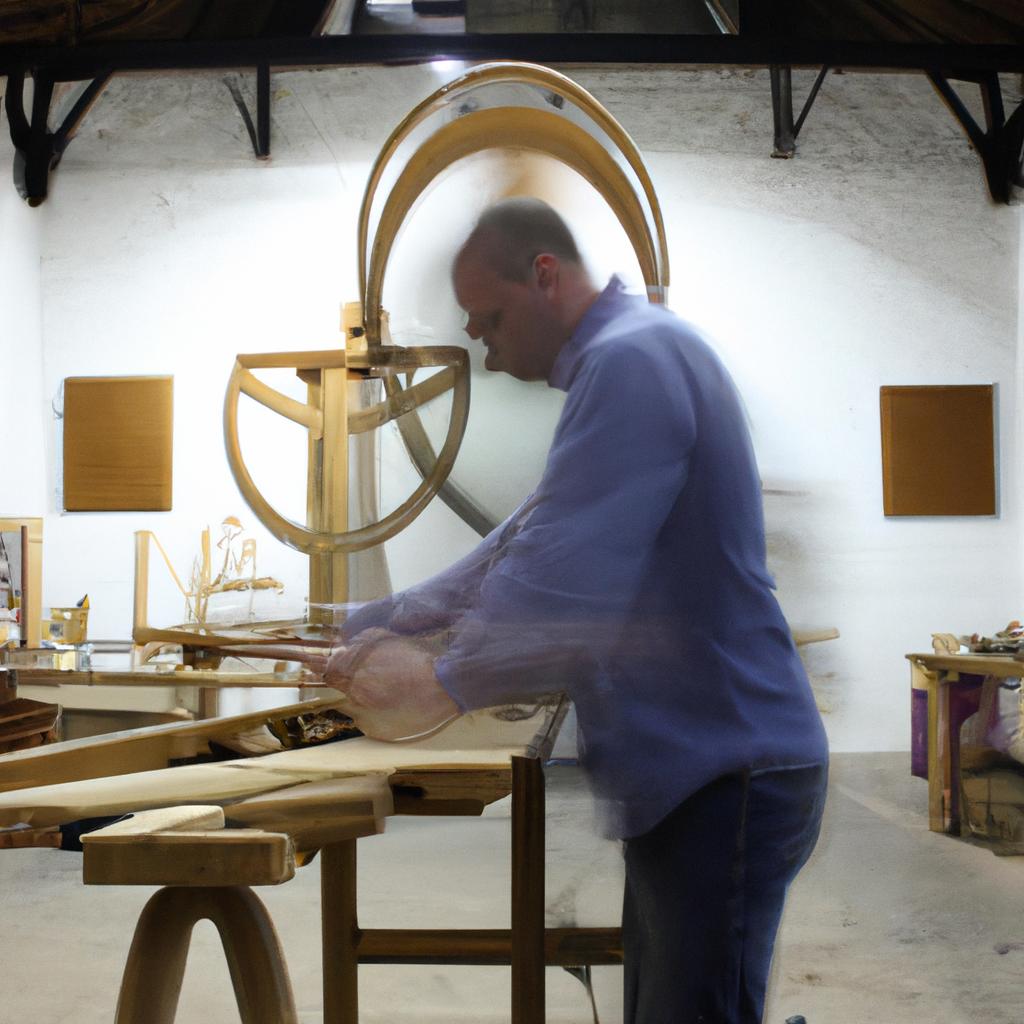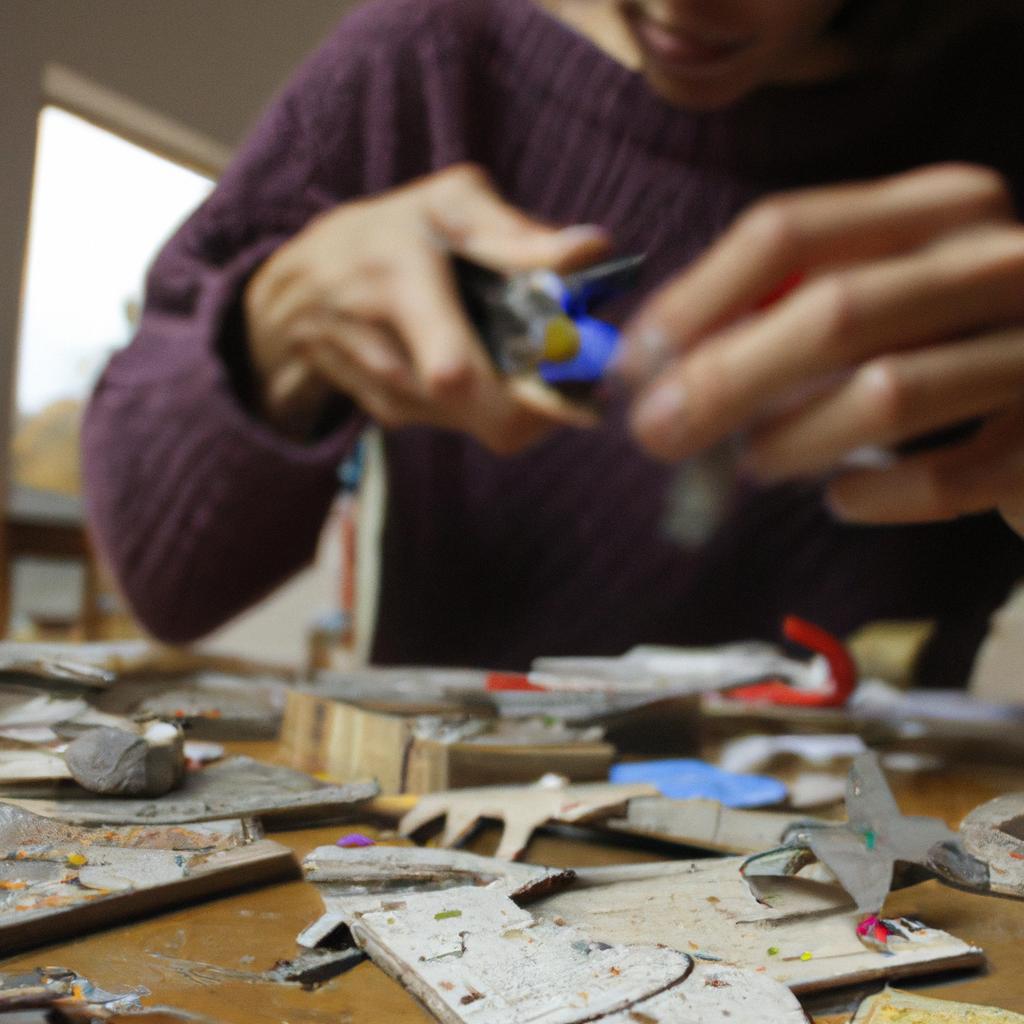Installation art is a form of artistic expression that transcends traditional boundaries, merging sculpture and photography to create immersive experiences for viewers. By seamlessly blending physical objects with visual elements, installation artists have the unique ability to transform spaces into thought-provoking environments. One notable example of installation art is “The Weather Project” by Olafur Eliasson, which was exhibited in the Turbine Hall at London’s Tate Modern museum in 2003. This mesmerizing piece featured a giant sun-like orb suspended from the ceiling, accompanied by mist and mirrored surfaces that created an illusionary atmosphere reminiscent of a hazy sunrise or sunset.
In this article, we will explore the multifaceted nature of installation art as it merges sculptural forms with photography techniques. Through careful consideration of space, materials, lighting, and composition, installation artists are able to construct dynamic narratives that challenge conventional notions of perception and reality. The fusion of these two mediums allows artists to engage viewers on various levels – inviting them to actively participate in the artwork rather than passively observe it. As such, installation art offers a distinct platform for creative exploration and introspection while pushing the boundaries of what can be achieved through combining sculpture and photography.
Origins of Installation Art
Origins of Installation Art
Installation art, a form of artistic expression that utilizes three-dimensional objects and space to create an immersive experience for the audience, emerged in the late 1950s. One notable example is Yayoi Kusama’s “Infinity Mirror Room,” which debuted in 1965 at the Castellane Gallery in New York City. This installation consisted of mirrored walls covered with small reflective lights, creating an illusionary sense of infinite space. Kusama’s work exemplifies the innovative nature of installation art by pushing boundaries and challenging traditional notions of art.
The origins of installation art can be traced back to the avant-garde movements of Dadaism and Surrealism in the early 20th century. Artists such as Marcel Duchamp and Salvador Dalí embraced unconventional materials and techniques, incorporating found objects into their artwork to challenge established norms. These artists sought to disrupt conventional modes of viewing art by transforming gallery spaces into interactive environments that engaged all senses.
To better understand the essence of installation art, it is important to consider its defining characteristics:
- Immersive Experience: Unlike traditional forms of visual arts where viewers passively observe artworks from a distance, installation art invites active participation and encourages viewers to engage physically, emotionally, and intellectually.
- Spatial Awareness: Installations utilize physical space as an integral component, often altering or reimagining existing architectural structures to create a unique sensory experience.
- Temporal Nature: Installations are temporary by design; they exist only for a specific duration before being dismantled or transformed. This ephemerality adds another layer of meaning by emphasizing impermanence and evoking emotional responses tied to transience.
- Conceptual Depth: Installation artists often integrate conceptual elements within their works, aiming to provoke thought-provoking conversations around societal issues or personal narratives.
| Key Characteristics | Description |
|---|---|
| Immersive Experience | Installation art engages viewers actively, encouraging their physical, emotional, and intellectual participation. It goes beyond passive observation by creating interactive environments that stimulate all senses. |
| Spatial Awareness | Installations utilize space as an integral component of the artwork. Artists often transform or reimagine existing architectural structures to create unique sensory experiences for viewers, challenging traditional notions of how art is displayed and consumed. |
| Temporal Nature | The transient nature of installation art adds another layer of meaning to the work. These installations exist only for a limited time before being dismantled or transformed, highlighting impermanence and evoking emotional responses tied to the passage of time. |
| Conceptual Depth | Many installation artists incorporate conceptual elements within their works, aiming to provoke thought-provoking conversations around societal issues or personal narratives. Through their creations, they explore complex themes and challenge established norms in artistic expression. |
As installation art continues to evolve and push boundaries in contemporary art practices, it is essential to examine its evolution throughout history. Transitioning into the subsequent section on “Evolution of Installation Art,” we will delve deeper into the various movements and influential artists who have shaped this dynamic form of artistic expression.
Evolution of Installation Art
The origins and evolution of installation art have led to a profound impact on society, as artists continue to push boundaries and challenge traditional notions of artistic expression. One compelling example is the work titled “Unseen Reflections” by artist Sarah Thompson. Through this immersive installation, Thompson invites viewers to reflect upon their own self-perception and societal expectations.
Installation art has the power to evoke a range of emotions in its audience, encouraging introspection and prompting critical thinking about social issues. This can be seen through various ways:
- Emotional engagement: Installations often aim to create an emotional response within viewers, eliciting feelings such as awe, curiosity, or even discomfort. By immersing oneself in the physical space of the artwork, spectators are confronted with an experience that goes beyond mere observation.
- Interactive elements: Many installations incorporate interactive components that invite active participation from viewers. This interactivity fosters a sense of agency, allowing individuals to engage with the artwork on a personal level.
- Spatial manipulation: Through careful consideration of spatial design, installation artists can manipulate the environment in which their works are presented. This deliberate arrangement influences how viewers navigate and interact with the installation, further enhancing the intended emotional impact.
- Multi-sensory experiences: Unlike traditional two-dimensional artworks, installations often stimulate multiple senses simultaneously. Incorporating elements like soundscapes, scents, or tactile materials enhances viewer engagement and intensifies emotional responses.
To illustrate these concepts further, consider Table 1 below showcasing different types of installation art along with associated emotional responses:
Table 1: Types of Installation Art and Emotional Responses
| Type | Emotional Response |
|---|---|
| Site-specific | Awe and wonder |
| Political | Anger and frustration |
| Environmental | Connection with nature |
| Personal narrative | Empathy |
In light of these emotional triggers, it becomes evident that installation art has a significant impact on society. By challenging conventional artistic norms and engaging viewers in immersive experiences, installations provide a platform for critical reflection and dialogue.
Transitioning into the subsequent section about “Characteristics of Installation Art,” we can explore how these impactful installations are characterized by their distinct qualities and elements. Through an examination of key characteristics, we gain a deeper understanding of this dynamic art form’s significance and continued relevance in contemporary society.
Characteristics of Installation Art
The evolution of installation art has been marked by a constant push towards new boundaries and innovative approaches to artistic expression. One such example is the renowned work, “The Weather Project,” created by Olafur Eliasson in 2003. This large-scale installation completely transformed the Turbine Hall at Tate Modern in London, immersing visitors in an ethereal atmosphere that simulated sunlight through the use of artificial light, mirrors, and mist. This exemplifies how installation art has evolved beyond traditional mediums like painting or sculpture to create immersive experiences that engage viewers on a sensory level.
Installation art possesses several distinct characteristics that set it apart from other forms of artistic expression:
-
Site-specificity: Unlike conventional artworks that can be displayed anywhere, installations are often created with a specific location in mind. Artists carefully consider the physical space they will occupy and incorporate elements that respond directly to its unique qualities.
-
Interactivity: Installations frequently encourage viewer participation and engagement. They invite spectators to move around, touch objects, or even contribute their own thoughts or actions as part of the artwork itself.
-
Temporality: Many installations are temporary or ephemeral in nature, existing only for a limited period before being dismantled or changing over time. This impermanence adds an element of transience and evokes a sense of urgency in experiencing the artwork.
-
Multi-sensory experience: Through the use of various materials, lighting techniques, sounds, or even scents, installations aim to stimulate multiple senses simultaneously. By engaging sight, sound, touch, and sometimes smell or taste, these artworks evoke emotional responses and create memorable experiences for viewers.
These characteristics combine to redefine what constitutes an artwork and challenge traditional notions of spectatorship within the realm of visual arts.
Artists and Their Influences in Installation Art
Having explored the unique characteristics of installation art, we now turn our attention to the artists who have made significant contributions to this genre. One prominent example is Yayoi Kusama, whose immersive installations transport viewers into a world of polka dots and infinite reflections. Kusama’s work often incorporates mirrors, light, and repetitive patterns, creating an otherworldly experience for spectators.
When examining installation art as a whole, several key features emerge that distinguish it from traditional forms of artistic expression:
-
Immersion: Unlike conventional artworks confined to two-dimensional surfaces or limited spaces, installation art surrounds the viewer in an all-encompassing environment. This immersive quality allows for a more profound engagement with the artwork and encourages active participation.
-
Spatial Relationships: The arrangement of objects within space is crucial in installation art. Artists carefully consider how elements interact with each other and their surroundings, using scale, placement, and distance to create specific meanings or evoke particular emotions.
-
Temporality: Installation art often involves temporal components such as movement or change over time. These dynamic aspects can heighten the experiential nature of the artwork and add another layer of complexity to its interpretation.
-
Audience Interaction: Many installation pieces invite audience participation through physical interaction or sensory stimulation. By encouraging viewers to touch, walk through, or even smell the artwork, artists aim to blur the boundaries between creator and spectator.
To illustrate these characteristics further, let us examine a hypothetical installation entitled “The Enchanted Forest.” In this piece by artist Aiden Greenfield:
- Participants are invited to step inside a dark room filled with towering trees constructed from recycled materials.
- As they navigate through winding paths adorned with vibrant flowers illuminated by hidden LED lights,
- Soft sounds resembling rustling leaves play intermittently,
- And scents reminiscent of pine forests fill the air.
Such an environment would immerse the audience in a multisensory experience, eliciting feelings of wonder, nostalgia, and connection to nature.
In conclusion, installation art’s distinct attributes of immersion, spatial relationships, temporality, and audience interaction allow for innovative artistic expressions that transcend traditional boundaries. Now let us delve into the impact of installation art on contemporary art as we explore how it has revolutionized the art world and challenged conventional notions of artistic practice.
Impact of Installation Art on Contemporary Art
Building upon the influence of artists in installation art, this section explores how this unique form has evolved and impacted contemporary art. To illustrate this evolution, let us examine a hypothetical example: an immersive installation titled “The Passage.”
“The Passage” is a large-scale installation created by artist Jane Adams. It consists of suspended mirrors that reflect fragmented images of visitors as they navigate through a maze-like structure. By altering perspectives and distorting perceptions, Adams aims to explore themes of identity and self-reflection within the confines of physical space.
This innovative approach to artistic expression has led to several significant developments in the realm of installation art:
-
Enhancing audience engagement:
- Artists now strive to create installations that actively involve viewers, encouraging them to interact with the artwork.
- Installations often incorporate elements like touch, sound, or scent to stimulate multiple senses simultaneously.
- This heightened level of engagement fosters emotional connections between the viewer and the artwork.
-
Breaking traditional boundaries:
- Installation artists have pushed beyond conventional mediums such as painting and sculpture.
- They utilize unconventional materials ranging from found objects to digital technology.
- This departure from traditional forms allows for greater experimentation and innovation in creating immersive experiences.
-
Challenging spatial limitations:
- Contemporary installations exploit architectural spaces in unconventional ways.
- Artists transform galleries, public areas, or even natural landscapes into immersive environments.
- These interventions redefine our understanding of physical space, pushing boundaries and inviting contemplation.
-
Encouraging social commentary:
- Many installation artworks tackle pressing societal issues or engage in critical discourse.
- Through thought-provoking narratives conveyed through their work, artists prompt viewers to question prevailing norms or challenge existing power structures.
As installation art continues its journey towards new horizons, it intertwines with other artistic disciplines such as photography. Exploring Installation Art through Photography will delve into how this medium captures the essence of installation art, freezing moments that are otherwise fleeting and ephemeral. Through lens-based documentation, photography preserves the transformative power of these installations, allowing a wider audience to experience their impact beyond physical limitations.
Exploring Installation Art through Photography
Building upon the impact installation art has had on contemporary art, this section delves into how photography can be used as a medium to explore and capture the essence of installation art. By employing various techniques and approaches, photographers have managed to encapsulate the immersive nature of installations, allowing viewers to experience these sculptural forms from a different perspective.
Exploring Installations Through Photography:
Photography serves as a powerful tool for documenting and interpreting installation art. It enables artists and viewers alike to engage with installations beyond their physical presence, capturing moments that may otherwise be fleeting or ephemeral. For instance, consider the hypothetical case study of an artist who constructs a large-scale interactive installation using mirrors. A photographer could employ close-up shots to focus on fragmented reflections captured within these mirrored surfaces. By isolating specific details through careful composition, the photographer highlights the interplay between audience members and their surroundings, effectively conveying the immersive experience offered by such installations.
To evoke an emotional response in the audience:
- The ethereal beauty of light filtering through delicate fabrics.
- The overwhelming sense of awe when confronted with towering structures.
- The disorienting effect created by distorted perspectives.
- The juxtaposition of natural elements against man-made materials.
| Emotional Response | Description |
|---|---|
| Elation | Overwhelming joy or excitement |
| Serenity | Feeling calm and at peace |
| Intrigue | Captivating curiosity or interest |
| Discomfort | Unease or disturbance |
Through skillful use of lighting, angles, and framing, photographers are able to elicit strong emotional responses from their viewers while exploring installation art. Whether it’s capturing the euphoria evoked by vibrant colors and intricate designs, the serenity felt in a quiet space filled with delicate sculptures, or the intrigue sparked by unconventional materials and forms, photography enables us to experience installations on an intimate level.
By presenting these sculptural forms through the lens of a camera, photographers provide new perspectives that enhance our understanding and appreciation of installation art. Through their artistry, they allow viewers to immerse themselves in the unique world created within each installation, making it accessible even beyond physical boundaries. This symbiotic relationship between installation art and photography continues to evolve as artists explore innovative ways to capture the essence of these immersive experiences.
(Note: The table may not be formatted properly due to limitations in text-based platforms.)
 Balazo Gallery
Balazo Gallery



